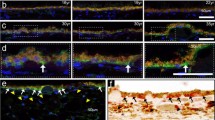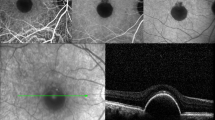Abstract
N-methyl-N-nitrosourea (MNU) is known to cause apoptosis of photoreceptor cells and changes in retinal pigment epithelium (RPE). However, the changes in choriocapillaris, which nourishes photoreceptor cells by diffusing tissue fluid through RPE, have not been reported in detail. Therefore, we studied the ultrastructural transformation in and around the choriocapillaris to characterize the interdependence between choriocapillaris and surrounding tissue components in a mouse model. Seven-week-old male C57BL/6 mice were given a single intraperitoneal injection of MNU (60 mg/kg of body weight). Perfusion-fixed eyeballs were examined chronologically using immunohistochemistry and electron microscopy until the photoreceptor cells were lost. Sequential ultrastructural changes were observed in photoreceptor cells, RPE, Bruch’s membrane, choriocapillaris, and choroidal melanocytes after an MNU injection. The lumens of the choriocapillaris narrowed following dilation, and the vascular endothelium showed structural alterations. When the photoreceptor cells were completely lost, the choriocapillaris appeared to be in a recovery process. Our results suggest that transport abnormality through Bruch’s membrane and structural changes in the choroid might have influenced the morphology of choriocapillaris. The thin wall of the choriocapillaris appears to be the cause of the vulnerability with its altered morphology.







Similar content being viewed by others
Abbreviations
- MNU:
-
N-Methyl-N-nitrosourea
- RPE:
-
Retinal pigment epithelium
- CC:
-
Choriocapillaris
- ONL:
-
Outer nuclear layer
- OPL:
-
Outer plexiform layer
- IS:
-
Inner segments
- OS:
-
Outer segments
- GCL:
-
Ganglion cell layer
- IPL:
-
Inner plexiform layer
- INL:
-
Inner nuclear layer
- BL:
-
Basal lamina
- OCL:
-
Outer collagenous layer
- ICL:
-
Inner collagenous layer
- PB:
-
Phosphate buffer
- PBS:
-
Phosphate-buffered saline
References
Strauss O (2005) The retinal pigment epithelium in visual function. Physiol Rev 85:845–881
Blaauwgeers HGT, Holtkamp GM, Rutten H, Witmer AN, Koolwijk P, Partanen TA, Alitalo K, Kroon ME, Kijlstra A, Hinsbergh VWM, Schlingemann RO (1999) Polarized vascular endothelial growth factor secretion by human retinal pigment epithelium and localization of vascular endothelial growth factor receptors on the inner choriocapillaris evidence for a trophic paracrine relation. Am J Pathol 155:421–428
Saint-Geniez M, Maldonado AE, D’Amore PA (2006) VEGF expression and receptor activation in the choroid during development and in the adult. Investig Ophthalmol Vis Sci 47:3135–3142
Almeida DRP, Zhang L, Chin EK, Mullins RF, Kucukevcilioglu M, Critser DB, Sonka M, Stone EM, Folk JC, Abràmoff MD, Russell SR (2015) Comparison of retinal and choriocapillaris thicknesses following sitting to supine transition in healthy individuals and patients with age- related macular degeneration. JAMA Ophthalmol 133:297–303
Freddo TF, Chaum E (2018) Choroid and choroidal circulation. Anatomy of the eye and orbit: the clinical essentials. Wolters Kluwer, Philadelphia, pp 181–192
Yoneya S, Tso MOM, Shimizu K (1983) Patterns of the choriocapillaris. A method to study the choroidal vasculature of the enucleated human eye. Int Ophthalmol 6:95–99
Lutty GA, Hasegawa T, Baba T, Grebe R, Bhutto I, McLeod D (2010) Development of the human choriocapillaris. Eye 24:408–415
Wolter JR, Mich AA (1955) Melanoblasts of the normal human choroid. Arch Ophthalmol 53:211–214
Matsusaka T (1982) Cytoarchitecture of choroidal melanocytes. Exp Eye Res 35:461–469
Herrold KM, Bethesda M (1967) Pigmentary degeneration of the retina induced by N-methyl-N-nitrosourea. Arch Ophthalmol 78:650–653
Ogino H, Ito M, Matsumoto K, Yagyu S, Tsuda H, Hirono I, Wild CP, Montesano R (1993) Retinal degeneration induced by N-methyl-N-nitrosourea and detection of 7-methyldeoxyguanosine in the rat retina. Toxicol Pathol 21:21–25
Yuge K, Nambu H, Senzaki H, Nakao I, Miki H, Ueyama M, Tsybura A (1996) N-methyl-N-nitrosourea-induced photoreceptor apoptosis in the mouse retina. Vivo (Brooklyn) 10:483–488
Nambu H, Yuge K, Nakajima M, Shikata N, Takahashi K, Miki H, Uyama M, Tsubura A (1997) Morphologic characteristics of N-methyl-N-nitrosourea-induced retinal degeneration in C57BL mice. Pathol Int 47:377–383
Chen YY, Liu SL, Hu DP, Xing YQ, Shen Y (2014) N-methyl-N-nitrosourea-induced retinal degeneration in mice. Exp Eye Res 121:102–113
Komoike NK, Saitoh F, Komoike Y, Fujieda H (2016) DNA damage response in proliferating Müller glia in the mammalian retina. Investig Ophthalmol Vis Sci 57:1169–1182
Quraish R, Sudou N, Nomura-komoike K, Sato F, Fujieda H (2016) p27 KIP1 loss promotes proliferation and phagocytosis but prevents epithelial—mesenchymal transition in RPE cells after photoreceptor damage. Mol Vis 22:1103–1121
Curcio CA, Johnson M (2013) Structure, function, and pathology of Bruch’s membrane. Retina 1(Part 2):465–481
Iversen OH (1982) Enhancement of methyl-nitrosourea skin carcinogenesis by inhibiting cell proliferation with hydroxyurea or skin extracts. Carcinogenesis 3:881–889
Jensen D, Stelman G, Spiegel A (1987) Species differences in blood-mediated nitrosocimetidine. Cancer Res 47:353–359
Tinwell H, Paton D, Guttenplan JB, Ashby J (1996) Unexpected genetic toxicity to rodents of the N′, N′-dimethyl analogues of MNU and ENU. Environ Mol Mutagen 27:202–210
Matsusaka T (1970) Microstructure of retinal capillaries. Ganka 12:659–673
Nakaizumi Y (1964) The ultrastructure of Bruch’s membrane. Arch Ophthalmol 72:380–387
Arya M, Sabrosa AS, Duker JS, Waheed NK (2018) Choriocapillaris changes in dry age-related macular degeneration and geographic atrophy: a review. Eye Vis 5:1–7
Moreira-Neto CA, Moult EM, Fujimoto JG, Waheed NK, Ferrara D (2018) Choriocapillaris loss in advanced age-related macular degeneration. J Ophthalmol 12:1–6
Nazari H, Hariri A, Hu Z, Ouyang Y, Sadda S, Rao NA (2014) Choroidal atrophy and loss of choriocapillaris in convalescent stage of Vogt–Koyanagi–Harada disease: in vivo documentation. J Ophthal Inflamm Infect 4:1–9
Aggarwal K, Agarwal A, Deokar A, Mahajan S, Singh R, Bansal R, Sharma A, Dogra MR, Gupta V, the OCTA Study Group (2017) Distinguishing features of acute Vogt–Koyanagi–Harada disease and acute central serous chorioretinopathy on optical coherence tomography angiography and en face optical coherence tomography imaging. J Ophthalmic Inflamm Infect 7:3
Lane M, Moult EM, Novais EA, Louzada RN, Cole ED, Lee B, Husvogt L, Keane PA, Denniston AK, Witkin J, Baumal CR, Fujimoto JG, Duker JS, Waheed NK (2016) Visualizing the choriocapillaris under Drusen: comparing optical coherence tomography angiography. Invest Ophthalmol Vis Sci 57:585–590
Acknowledgements
We thank Ms. Sachie Matsubara and Ms. Junri Hayakawa of the Laboratory for Electron Microscopy, Kyorin University School of Medicine, who employed their expertise in helping our team to obtain excellent digital electron microscopic images for this research. This study was initiated by Shunichi Morikawa (Ph.D.), a devoted researcher at Tokyo Woman’s Medical University. His passion to investigate the choroidal microcirculation was diligently inherited by our team after his untimely death at a young age in 2017. We are indebted to him for his dedication and leadership in making this research happen. We are also thankful to Ms. Hiromi Sagawa and Ms. Kae Motomaru, Department of Microscopic and Developmental Anatomy, Tokyo Women’s Medical University, for constantly supporting us to achieve this goal. Finally, we would like to thank Ms. Kaoru Otsuka for language support in producing the English article.
Author information
Authors and Affiliations
Corresponding author
Ethics declarations
Conflict of interest
There are no conflicts of interest to declare.
Additional information
Publisher's Note
Springer Nature remains neutral with regard to jurisdictional claims in published maps and institutional affiliations.
Rights and permissions
About this article
Cite this article
Hayakawa, R., Komoike, K., Kawakami, H. et al. Ultrastructural changes in the choriocapillaris of N-methyl-N-nitrosourea-induced retinal degeneration in C57BL/6 mice. Med Mol Morphol 53, 198–209 (2020). https://doi.org/10.1007/s00795-020-00246-6
Received:
Accepted:
Published:
Issue Date:
DOI: https://doi.org/10.1007/s00795-020-00246-6




